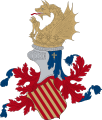Canals, Valencia
Canals is a municipality (pop., INE 2007: 13,771) in the comarca of Costera in the Valencian Community, Spain.
Canals | |
|---|---|
_2012-09-24_22-47-33.jpg) | |
 Coat of arms | |
 Canals Location in Spain | |
| Coordinates: 38°57′40″N 0°35′6″W | |
| Country | |
| Autonomous community | |
| Province | Valencia |
| Comarca | Costera |
| Judicial district | Xàtiva |
| Government | |
| • Alcalde | María José Castells Villalta (2019) (Compromís) |
| Area | |
| • Total | 21.90 km2 (8.46 sq mi) |
| Elevation | 160 m (520 ft) |
| Population (2018)[1] | |
| • Total | 13,588 |
| • Density | 620/km2 (1,600/sq mi) |
| Demonym(s) | Canalí(Catalan) Canalense (Spanish) |
| Time zone | UTC+1 (CET) |
| • Summer (DST) | UTC+2 (CEST) |
| Postal code | 46650 |
| Official language(s) | Valenciano |
| Website | www.canals.es |
It shares borders with the municipalities of l'Alcúdia de Crespins, Cerdà, la Granja de la Costera, Xàtiva, Llanera de Ranes, Montesa, Torrella and Vallés (in the same comarca) and with Aielo de Malferit and l'Olleria (comarca of Vall d'Albaida).
Geography
Canals is located in the valley of Montesa, between the Grossa mountains and la Costera. The highest points are in la Serra Grossa, where we can find the peaks of l'Atalaia (556 m) and la Creu (520 m), on the municipal boundary with l'Olleria. The Cànyoles River crosses the town in the west-northeast direction; the Sants River begins its course close to town, where it divides into two channels (séquies) that bring water to Xàtiva and the fields of Canals.
The village lies on the left bank of the Cànyoles river. Canals and l'Alcúdia de Crespins together form a conurbation.
From València you can reach Canals taking the A-7 highway.
Towns of the municipality
- Canals
- Aiacor
- Torre d'En Cerdà, or Torre dels Frares.
History
Some evidence of Roman civilization has been found. During the year of Muslim occupation it was a very important "alqueria" owned by Xàtiva.
Then in the Christian era, in 1244, king James I of Aragon gave Dionís of Hungary the tower and the small village of Canals and created the new lordship of the Señorío de Torre de Canals. Dionis of Hungary gave the king the castle in the valley of Veo and also the castle of Ain and other territories. The Christian resettlement was made by Catalans. On July 30, Peter IV "el Cerimoniós" gave the place to Raimon de Riusech taking it from Joan Eximenis d'Urrea, with the condition that if he had no male descendants it would be given back to the crown, but in the end it was sold to Xàtiva, with the king's approval on February 19 of 1353 as a barony. During the rule by Xàtiva there were continuous tributary conflicts. In the year 1506 Xàtiva bought La Torreta.
In 1522 during the Revolt of the Brotherhoods, Canals was used by the viceroy as his headquarters to attack Xàtiva, where the 'Encobert' was hidden. Many prisoners were taken from Xàtiva to Canals. In 1639 Phillip IV, paid Xàtiva 20.000 pounds, and gave independence to Canals as a village (vila). In the 19th century Canals developed industry, with 24 glass factories, a paper factory, metal workshops, flour mills, and cloth sellers. In the 20th century this industrial activity increased with oil, furniture, construction materials, leather and cloth production.
Demography
| Canals demography evolution | |||||||||||||||||||
|---|---|---|---|---|---|---|---|---|---|---|---|---|---|---|---|---|---|---|---|
| 1900 | 1910 | 1920 | 1930 | 1940 | 1950 | 1960 | 1970 | 1981 | 1991 | 1996 | 2002 | 2006 | 2007 | ||||||
| 4.695 | 4.857 | 4.967 | 5.261 | 5821 | 6.176 | 7.350 | 9.080 | 11.151 | 12.185 | 12.886 | 13.040 | 13.150 | 13.771 | ||||||
People from Canals
- Alfons de Borja, Pope Callixtus III
Economy
The economy is divided into agriculture (oranges), industry famous for its clothing and leather production (Ferry's, Rodrigo Sancho S.A.), and marble. Today the industry is almost dead with the main companies having closed down: Ferry's (2007), Argent (2008), Rodrigo Sancho S.A. (2010), and many others.
Pottery has also been very important, and has given the people from Canals the nickname of "perolers" (potters).
References
External links
- Canals Actualitat La web lider en noticies i opinions de Canals.
- Ajuntament de Canals
- Assemblea de Joves de Canals
- Enllaç a Canals en el google maps
- Conèixer Canals, Web per a conèixer la població de la Costera, Canals
- La Costera Digital, Periòdic independent de la Costera, Canals.
- Institut Valencià d'Estadística
- Portal de la Direcció General d'Administració Local de la Generalitat
- AI MARE!, Web de fotos i videos d'humor feta a Canals
- 4Q-QUARTET - Quartet de trombons
- Associació Musical Canalense
- Municipal Register of Spain 2018. National Statistics Institute.
